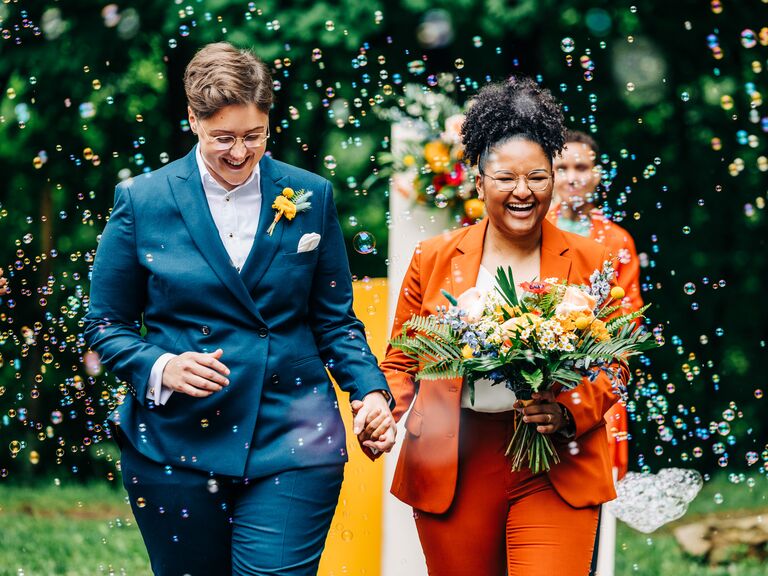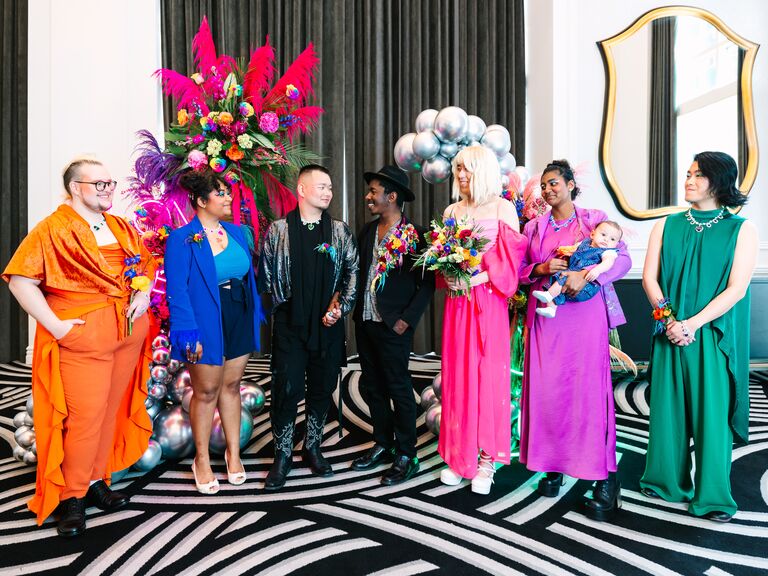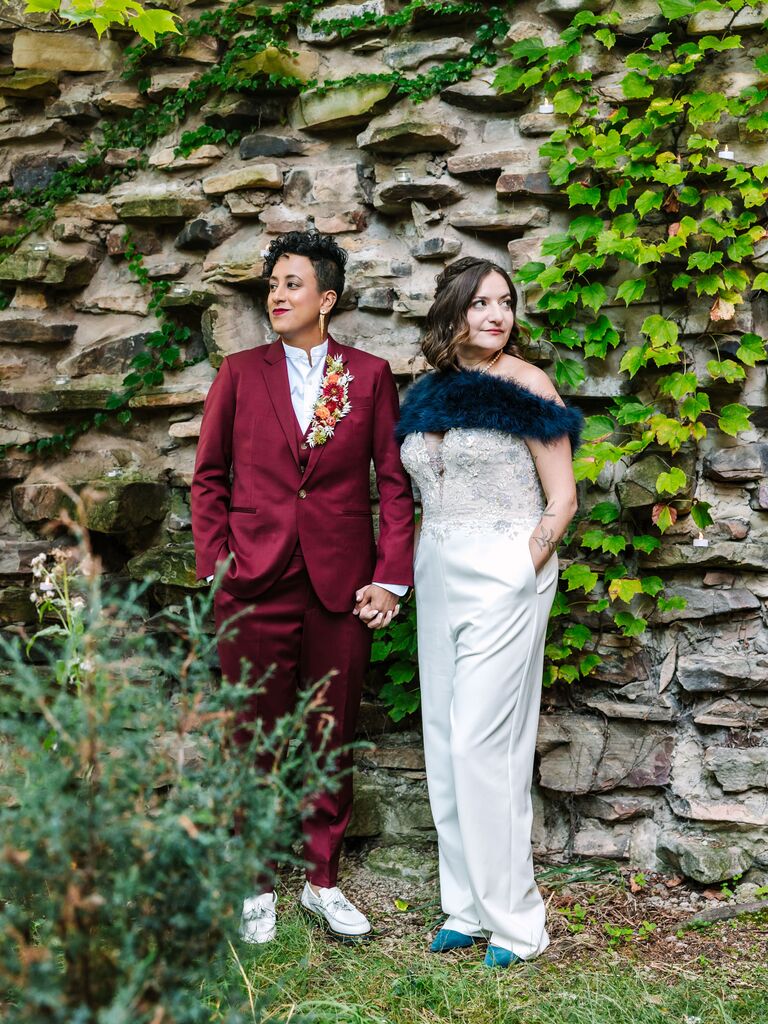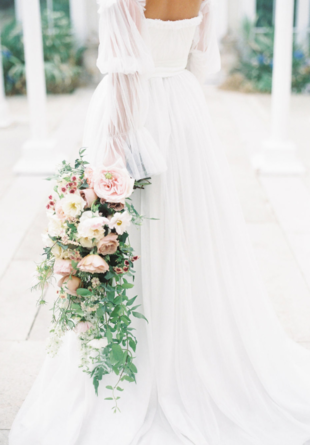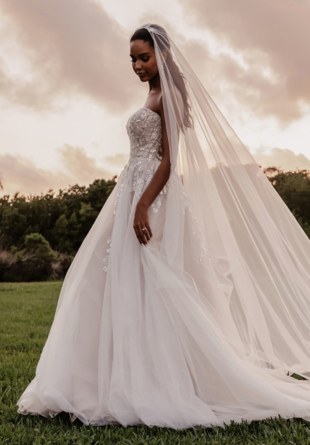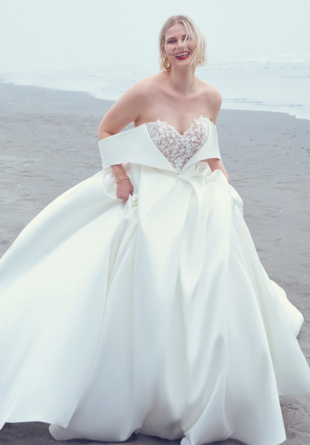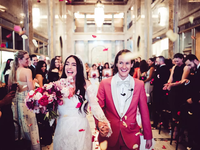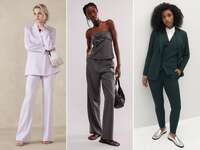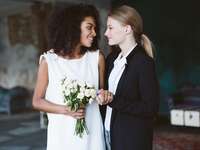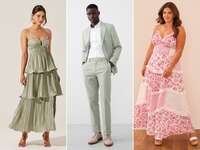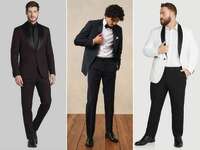How to Choose a Nonbinary Wedding Outfit That Delivers Gender Euphoria

For to-be-weds and wedding guests who identify outside of or somewhere in the middle of the male/female binary, the search for a nonbinary wedding outfit that delivers gender euphoria can be a challenge. Much like what occurs while shopping for gender-neutral wedding fashion, the clothing displayed on both digital and physical racks of today is often created for and marketed along binary lines. Not all customers are aligned with binary thinking, bringing about even more dilemma when adhering to gendered dress code. To address these conundrums, we tapped a few nonbinary, trans and queer wedding pros and fashion creatives for their input.
While clothing has no gender and gender itself is a social construct, internet searches for nonbinary formal wear are valid and we're here to help. But what does "dressing nonbinary" really mean? Maya Lovro, a nonbinary photographer and owner of Maya Lovro Photography, in Pittsburgh, who focuses their work on LGBTQ+, non-traditional and multicultural weddings and celebrations, says, "Society has a very binary expectation of gender presentation. Typically, we expect people to present feminine or masculine, and there's nothing wrong with either of those styles. And I don't necessarily think clothes tie to gender. I don't think that you are a gender because of the clothes you wear. But I choose to dress more androgynous just because I would like my gender expression to be visible in some sense."
Taralyn Thuot, the chief creative officer at queer-owned Wildfang, agrees that clothes are inherently gender-free. "Simply put, we just think people should be able to wear whatever the hell they want, regardless of where something might sit in a department store," she says. But when it comes to adhering to formal dress codes for weddings, there's a specific strategy that nonbinary folks can follow, says Lovro. The strategy is to shop for pieces instead of an entire outfit from one store or designer.
"It feels like a lot of the dialogue is what you're trying to break apart, right?" says Lei Bretón, Colombian-born trans nonbinary fashion designer and owner of House of Bretón. If neither masculine or feminine applies, they recommend breaking down the outfit by the elements. For example, for one of their clients, Bretón created a fluid, flowy and non-gendered outfit with a silk organza transparent blouse featuring puff sleeves juxtaposed against a crisp collar.
In this article:
- Nonbinary Wedding Attire for Guests
- Nonbinary Wedding Outfits for Couples
- Where to Shop for a Gender-Neutral Wedding Outfit
Nonbinary Wedding Attire for Guests
Lovro says that no matter the formality of the event, it's important for nonbinary wedding guests to go beyond the dress code when planning their outfits: "If you're a guest at a wedding, no matter what the fanciness level of the attire is, it's going to come down to a couple things. The first one is how inclusive are the people that are getting married? Are they your good friends? Do you know that they understand and respect your identity? Are they going to be upset if you do not conform to a binary? Personally, I would not be going to a wedding if it was someone who was going to be upset. But there are complex situations out there, and the whole world does not exist in black or white."
"Dressing well is a form of good manners," designer Tom Ford once said. Adhering to dress codes is important because you're showing respect to the couple or marriers by helping them achieve their vision of the wedding day. But following dress codes and personalizing your outfit to be true to yourself and your identity aren't mutually exclusive.
As for who wears what? Whether you're AFAB (assigned female at birth) or AMAB (assigned male at birth), being yourself in the appropriate level of formal dress is the goal.
Dress codes: White-Tie | Black-Tie | Formal | Cocktail | Semi-Formal | Casual | Western
White-Tie
Dressing for a white-tie wedding starts with understanding that this is the ultimate in formal events. Think tuxedo tailcoats that reach to the back of the knee, white French cuffed shirt, formal trousers, full-length evening gowns or ball gowns. Nonbinary and gender-nonconforming wedding guests aren't bound by who gets to wear trousers or gowns (neither are cisgender women and men, if we're being frank), so if you're feeling drawn to the gown, rock the frock. If pants and a formal jacket provide the gender euphoria you crave, then you know where to start your search.
"Whenever a dress code is that rigid," says Thuot, "accessories and hair and makeup play a critical role in making sure your outfit feels like you!" Think of a white-tie wedding as your invitation to dazzle with opulent jewelry, elbow-length white silk gloves, a hand-tied white bow tie, top hat and a cane.
Black-Tie
Black-tie dress code calls for tuxedos (never a suit) featuring a variety of—you guessed it—black ties. Formal gowns of any length are donned by the glam femmes. Consider adding your own genderqueer pizazz such as a cape (a la Lena Waithe at the Met).
Though black-tie outfits are traditionally not separate, wedding guests who defy gender norms might consider stepping slightly outside of the box of this strict dress code and creating their own rules, such as wearing a black bow tie with the formal gown or a tuxedo with a bodice underneath.
But if you're drawn to both feminine and masculine styles, Lovro says, "We're kind of inventing this as we go. There's not really a rule book, because the rules have been written for so long by this societal standard that we may or may not conform to our dress attire. We can choose to pick one or the other if you want something existing, or you can come up with something like working with a fashion designer or a tailor, or even with yourself, if you're more interested in forging a new path or blending something new, like taking elements from [both masculine and feminine]. I've seen some gorgeous pieces from designers on Instagram and other platforms as well that blend that high formal standards but take elements such as jumpsuits and pair them with flowy pieces, like capelets."
Formal
Formal attire (or black-tie optional) is the most likely dress code you'll see on a wedding invite (or wedding website). A formal attire noted on the wedding invite indicates that the wedding party will be in formal dress, and it's optional for the guests. This is still a formal event, of course. Just not as elevated as black or white tie. Choose from dark suits or tuxedos, or, on the feminine side, dresses. Full-length jumpsuit or pantsuits in any color (besides white, unless specifically requested) is allowed.
"This is where you really get to have fun," says Thuot. "I love how many different ways you can rock a suit and still make it feel like you. Shirt or no shirt. Tie or necklace. Blazer buttoned or unbuttoned. Belt or no belt. Pocket square or brooches. I take no issue with dresses but once you put it on...that's basically your outfit. Whereas a suit, you have so many variables to play with to make it feel right for the occasion and right for you."
Cocktail
The cocktail dress code is a fashionista's dream come true because the creative reins are slightly loosened, and guests can use versatile separates to achieve their cocktail attire. Think funky shoes, statement necklaces and unusual handbags to modernize your 'fit. Depending on the season, time of day and venue, you can have a bit more fun with the classics. Just be sure to not conflate cocktail attire and what you would wear to meet your besties for cocktails. For suits, that means expanding the color palette to navy and gray, or even losing the jacket altogether and just sporting a blazer. With dresses, technically you should opt for well-fitted styles that hit above, at or just below the knee, but we're spotting mid-thigh minis at many cocktail-attire weddings. Blur the lines of societal expectations by putting together your own androgynous cocktail attire that emphasize personality more than body shape, such as flowy pants and oversized dresses.
Semi-Formal
Semi-formal, which is also referred to as dressy casual, is like cocktail attire but it isn't as sleek. For feminine lines, you might wear a silk dress shirt with a midi-length skirt to a spring wedding, a tailored linen suit in the summer, a jumpsuit in the fall, and perhaps a velvet or satin maxi gown with a warm wrap for a winter wedding in a chillier location. Blurring the lines between masculine and feminine could have you adding items labeled as menswear but femming it up with fun and dressy baubles. A suit and tie work at any semi-formal wedding, but go for a relaxed and fun shade, like periwinkle, green or eggplant. Personalize it with your own flair, such as a colorful scarf in the winter or specialty lapel pins.
Casual
Is it casual now? Don't be fooled when you see the casual attire dress code for a wedding. The marriers aren't saying wear whatever to their casual wedding. Save your T-shirts and flip-flops for another time, and instead pull out the chic sandals, the sundress, a cotton maxi, chinos, the blazer to pair with a button-down shirt or a silk camisole. You might be able to get away with a polo shirt and dress shorts if the theme seems nautical or beachy, but ask another wedding guest or someone in the wedding party to be sure.
Of course, not all casual weddings occur in the summer. If you're invited to a casual winter wedding, think LBD, sweater dress, velvet trousers with a fun top, or a chunky cardigan and tweed pants.
Country, Western or Rustic
Western and rustic weddings tend to take place at barns, farms and ranches—or at least have those vibes. Don't go full-on Texas until you check out the wedding invite, wedding website or know that you are, in fact, attending a Texas wedding. For an all-out country wedding look, rustle up cowboy boots, a bolo, a Stetson-style hat, and pair it with an earth-hued linen dress or suit. If it's a casual wedding, swap out the linen dress for a midi (or mini) denim or a classic eyelet cotton dress with a bandana around your neck. Mix and max to your gender-expansive heart's delight.
Nonbinary Wedding Outfits for Couples
Nonbinary couples and marriers can find wedding inspiration in clothing marketed to men and women, as well as gender-neutral and unisex formal wear. Nothing is off-limits, and that's what makes it fun. Every nonbinary person has a different way of expressing themselves, and so there's no such thing as a nonbinary outfit. For Bretón's clients, who are primarily LGBTQ+, they often struggle with finding gender-affirming clothing and translating that to their wedding outfit.
"Some of my clients will come to me with something that they think is out of the box," says Bretón. "What I try to help them see is that they can take what they already like, and I can translate that into wedding attire." That's how Bretón created wed-veralls, a glowed-up version of one client's favorite type of clothing, using high-quality fabric, custom star buttons and bib, and a starry floor-grazing cape.
To achieve maximum gender euphoria with your wedding outfit, both Lovro and Bretón recommend tailored or fully custom attire. Having custom clothing ensures that you get the fit that feels most like you. This might mean that your wedding gown (or an androgynous wedding dress) has sewn-in padding to achieve a bust, a bigger bottom or an hourglass waist. Or you might have just a smidge of compression added to your undershirt for chest binding. A good tailor could let out the fabric on the legs by just an inch or two, and suddenly you're ecstatic because you finally just feel "right," says Bretón, whose primary clientele comes to them for just that kind of affirming service. "The tailoring really makes or breaks it, as far as the gender euphoria goes."
Get yourself a good tailor, advises Lovro. "It's worth getting your attire tailored because it just makes you feel so much better. Even if you are like a cis person that's not thought about gender once in your entire life, just having tailored clothing feels so good, because it's like, oh, this actually fits me. It can be a really gender-euphoric experience with the right person." To find an inclusive tailor in your area, start your search by asking LGBTQ+ friends, family and other inclusive vendors.
If you're nervous about shopping for gender-affirming clothing, remember that you don't have to go at it alone. Bretón says, "Go with somebody who is further along in their gender journey, and somebody who is unabashed about going into wherever they want to go, and go shopping, anywhere you want to go."
Where to Shop for a Gender-Neutral Wedding Outfit
Fashion companies with openly queer or trans founders such as House of Bretón, Wildfang, and Kirrin Finch, are your best bets for full assurance that your complete gender affirmation is their end goal. However, the industry is seeing a growth of LGBTQ+ inclusive clothing brands and gender-neutral suits that create their clothing for all bodies, no matter the birth-assigned gender.
We also appreciate the inclusive approach from brands like Suitshop, The Tailory, Sumissura, and Bindle and Keep. Separates sold by companies such as Eileen Fisher and Express are beloved by the LGBTQ+ community as well. Remember that no clothing is off-limits to you (if you're able to disengage from how it is marketed). Choose the styles and fabrics that make you feel empowered, and tailor them to fit authentically to you. Purchase from inclusive brands whenever possible for your own mental health and to support and grow the companies we need more of to help change the fashion industry.
